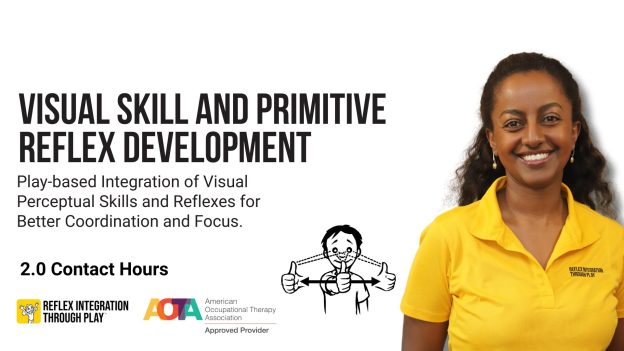1 in 4 children struggle with vision-related learning challenges — and it’s not always about 20/20.
Even with perfect eyesight, many children face hidden visual perception and motor integration issues that disrupt reading, writing, focus, and classroom behavior. This course helps pediatric specialists uncover what traditional vision screenings miss — and gives them the tools to act.
Research shows up to 60% of children with ADHD have underlying visual processing issues. This course helps pediatric therapists and educators identify vision-based challenges that mimic or amplify attention struggles — and shows how to treat them through movement, reflex integration, and skill-building.
Join the LIVE course and empower your therapy or education practice with neuroscience-informed strategiesDoes This Sound Like You?
- You work with children who struggle with reading, writing, or tracking in the classroom.
- You notice postural imbalances, poor coordination, or skipped lines when reading.
- You’re overwhelmed by the complexity of visual processing and reflex patterns.
- You want a simple, practical way to screen, understand, and support the children in your care.
- If so, this course was designed for YOU.
What You’ll Learn
- Recognize the stages of visual motor and perceptual development in early childhood.
- Identify common visual-motor dysfunctions in young children using observation-based tools.
- Recognize how retained primitive reflexes affect posture, coordination, and visual tracking.
- Identify how visual processing issues may mimic or contribute to attention and learning difficulties, including ADHD.
- Identify developmentally appropriate, play-based exercises to support reflex integration and visual-motor skill development.
- Recognize how to support reading, attention, and classroom performance through movement-based strategies that enhance coordination and focus.
Why This Course?
In pediatric therapy and education, unaddressed visual processing challenges and retained primitive reflexes can stall developmental progress, frustrate children, and delay academic success. Yet many professionals are not taught how to identify or address the root causes.
This course bridges that gap. With practical tools, clear frameworks, and movement-based interventions, you’ll confidently:
- Identify core visual motor delays
- Recognize retained reflexes influencing posture and coordination
- Design supportive and play-based exercises for better brain-body connection
- Walk away with actionable knowledge you can use immediately
Who This Course Is For
- Pediatric Occupational Therapists
- Physical Therapists
- Speech Therapists
- Educators and Special Education Teachers
- Students studying child development, education, or therapy
- Parent educators and early intervention specialists
Course Overview
This course is divided into clear, research-informed modules that integrate visual motor development, visual perceptual skills, and primitive reflex integration to support pediatric occupational therapists and educators.
Module 1: Foundations of Vision and Development (20 min)
- Overview of vision development in early childhood
- Anatomy of the eye and functional eye movements
- Differences between visual acuity and visual perception
Module 2: Visual Motor and Visual Perceptual Skill Development (20 min)
- Visual motor integration and its connection to function
- Core visual perceptual skills
- Visual perceptual red flags in children
- Clinical observations and performance impact
Module 3: Primitive Reflexes and Vision (20 min)
- Role of primitive reflexes in early development
- How retained reflex patterns interfere with ocular motor function, posture, head alignment, tracking, and attention
- Screening procedures
Module 4: Functional and Play-Based Interventions (20 min)
- Movement-based and play-based strategies
- Visual skill building exercises
Module 5: Clinical Applications and School Integration (25 min)
- Treatment planning strategies for occupational therapists
- Visual supports and adaptations in school settings
- Collaborative planning with educators and parents
- Home program development for carryover
Bonus: Therapist Toolkit
Final Quiz (10 min)
Exit Survey (5 min)
References
Anne S. Allen, Pat Nuse Pratt, et al. Occupational Therapy for Children‐3rd edition. 1996.
Patti Andrich, et al. Statistical Relationships Between Visual Skill Deficits and Retained Primitive Reflexes in Children. Optometry and Visual Performance, vol 6. 2018.
Carsone B, Green K, Torrence W, Henry B. Systematic Review of Visual Motor Integration in Children with Developmental Disabilities. Occup Ther Int. 2021.
M. Rhonda Folio, Rebecca R. Fewell. Peabody Developmental Motor Scales‐3rd edition. 2023.
Domingo-Sanz VA. Persistence of primitive reflexes associated with asymmetries in fixation and ocular motility values. J Eye Mov Res. 2024.
Erzsébet Sarlós. Investigating The Association Between Retained Primitive Reflexes and Partial Visual Abilities in Children Aged 4–8 Years. 4th Intl Conf on Adv Research in Education. 2021.
Sheng Zhou, et al. Improving children’s visual health by integrating motor imagery training into physical education classes. Front. Psychol. 2025.
You must log in and have started this course to submit a review.



